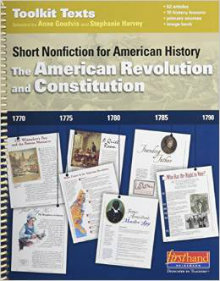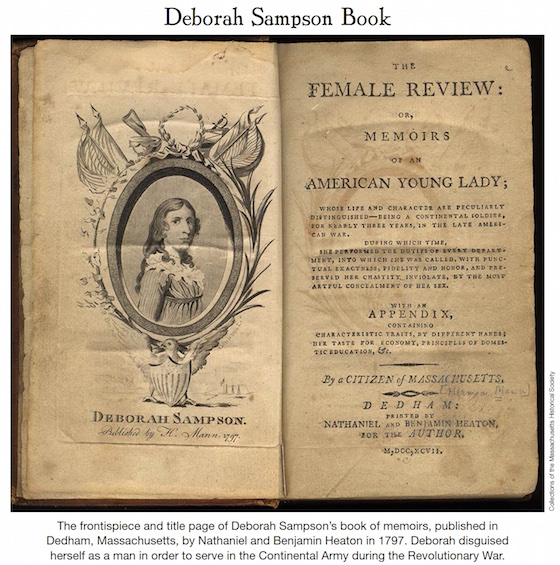Short Nonfiction Enlivens the American Revolution
The American Revolution and Constitution: Short Nonfiction for American History
By Anne Goudvis and Stephanie Harvey
(Heinemann, 2015 – Learn more)

When I received Goudvis and Harvey’s Short Nonfiction for American History: Colonial Times not long ago, I was so excited that I called my son Brian, who is a social studies teacher. “No more late night searches for the ‘right’ text! It’s all here!” He was equally impressed with the book and shared it with his supervisor and colleagues. Needless to say, it was a hit. We couldn’t wait until the next book in the Short Nonfiction series was published – The American Revolution and Constitution.

Social studies content and literacy
If you are looking for content-rich short passages to support your American history lessons, this is an indispensable resource. The book employs the same easily copied spriral-bound format used for Colonial Times (1600-1750), with an introduction to Disciplinary and Historical Literacy, correlation charts to social studies strands, and comprehension strategies for content literacy.
It is important to note that Disciplinary Literacy standards are not meant to replace existing content standards in our classrooms but rather to support them. Disciplinary literacy instruction is not an end in itself but rather a means to unlocking, communicating, and building history-specific critical thinking skills. Literacy support is found not only in books, but through maps, tables, charts, diagrams, oral histories, multimedia presentations, journals and articles, technical data, art, photographs, websites and sound clips.
Among the key features of this book are the 10 sample close reading lessons. Each lesson focuses on an important strategy such as reading and analyzing a primary source or comparing perspectives. Engaging texts are suggested for each objective with text dependent questions to guide the reading with enriching follow-up activities.
Easy-to-access digital resources
This series is already changing the way I teach social studies. It has opened my mind to the possibilities of using well-chosen primary and secondary resources to make my curriculum come alive. The authors provide along with more than 60 historical images in color which are perfect for projecting on the whiteboard. What better way for the students to “take a walk through history” by providing them with authentic texts about and from the era. (You can download a sampler here.)
Each article is carefully correlated to social studies strands – history, culture, economics, geography, and government. The texts are well written, interesting and thorough and are a worthy supplement to any textbook or curriculum. In addition, the authenticity of the primary sources enhances and deepens students’ comprehension of history. As they analyze and interpret the text, they discover what life was like long ago and can use what they are discovering to create their own interpretations.
The variety of genres gives the book a welcome perspective. For example, an interview with Louise Borden, author of Sleds on Boston Common, demonstrate the process of writing a historical fiction book and how the author effectively and accurately weaves history into a story. By accessing a variety of texts, the reader is able to view different perspectives on events in American history along with dispelling the myths surrounding history.
Our past and our present
This comprehensive resource covers a timeline of articles centering on “Leading up to the Revolution,” “Fighting the Revolution,” “Whose Revolution,” “Designing the Constitution,” and “A Lasting Legacy.” The concluding section reiterates the importance of how the present has been sharpened by our historical past, using interviews of immigrants, sample questions from the Naturalization Test, and examples of Supreme Court cases that promote social justice and equality.
Today’s standards require that students comprehend and analyze complex texts and write arguments or informational papers focused on discipline-specific texts. Today’s students need opportunities to examine a variety of texts to consider point of view and bias. They also benefit from learning materials that are not limited to the written word.
Ms. Goudvis and Ms. Harvey, thank you again for this exceptional resource. My colleagues and I are waiting in anticipation for the next two books in the series, Westward Expansion (1800–1850) and Civil War and Reconstruction (1850–1875). I am recommending this book to anyone who teaches social studies or sees the need to develop a critical foundation for students’ life-long participation as citizens.
“The supreme purpose of history is a better world.” – Herbert Hoover
Linda Biondi is a fourth grade teacher at Pond Road Middle School in Robbinsville, NJ, and a long-time Morning Meeting practitioner. She’s also the recipient of several educational grants, a Teacher Consultant with the National Writing Project and a participant on the NJ Department of Education Teacher Advisory Panel. Linda participates in ECET2 Celebrate Teaching which recently posted an interview with her.































